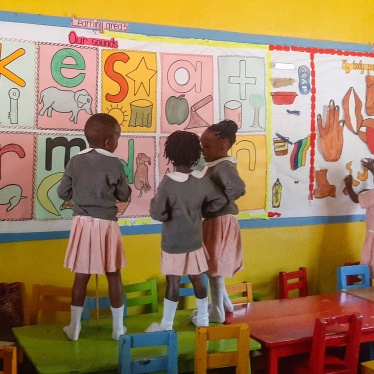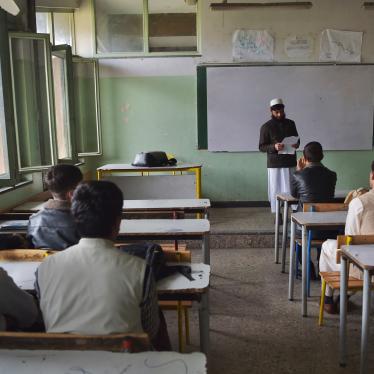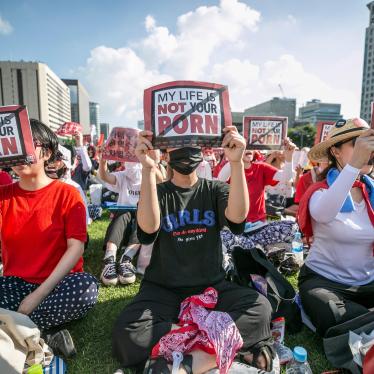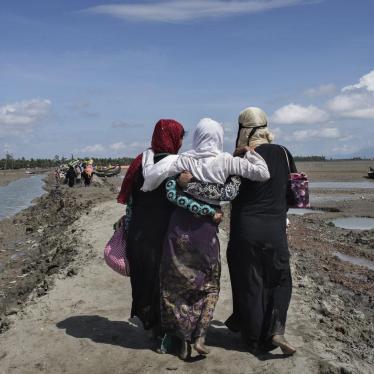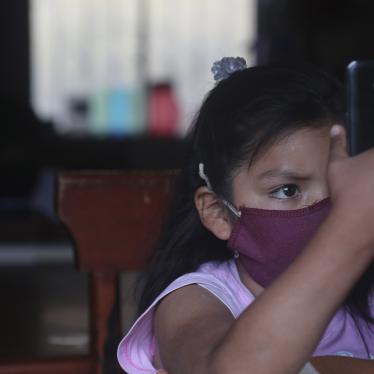For a full decade, the UN Security Council has addressed the severe abuses that children experience in armed conflict. Its response has included a series of six resolutions (1261, 1314, 1379, 1460, 1539, and 1612), the creation of a specialized working group, and the initiation of a monitoring and reporting mechanism on violations against children in armed conflict. The working group has now been functioning for 3 years, issuing 20 sets of conclusions on 11 country situations. The monitoring and reporting mechanism is now active in 13 countries. The Special Representative to the Secretary-General on children and armed conflict has followed up on the working group's conclusions by making regular field visits to engage with parties to armed conflict that remain responsible for violations against children.
These efforts have yielded some significant successes with regards to the use of child soldiers:
- five parties to the armed conflict in Cote d'Ivoire ended their use of child soldiers after agreeing to action plans to end the practice;
- the government of Uganda has been "de-listed" from the Secretary-General's list of violators after removing children from the Uganda People's Defense Forces and local defense units associated with the government;
- several non-state armed groups in Burma (Myanmar) have signed voluntary "deeds of commitment" committing to ending their use of child soldiers, and submitting to independent verification;
- as follow-up to the Security Council working group conclusions, the SRSG on children and armed conflict has secured commitments from parties to armed conflict in the Philippines, Nepal, Chad, Central Africa Republic and elsewhere to end the recruitment and use of child soldiers and/or to release children from their forces;
- some actors have agreed to action plans to demobilize child soldiers, although they have yet to be implemented fully.
The Security Council's efforts over the past decade have achieved positive results. However, children continue to be recruited and used in armed conflicts in at least 15 countries, and other grave violations also need urgent and focused attention.
Expanding and strengthening the Security Council's scope:
Although the Security Council has identified six grave violations against children in armed conflict, to date it has focused primarily on the recruitment and use of child soldiers. Other violations affect much larger numbers of children, and result in terrible and long-lasting consequences, but have not received the same focused international response.
Although all violations against children in armed conflict deserve greater attention, this paper focuses particularly on ways that the Security Council can enhance its response to sexual violence and attacks on education.
Sexual violence: Over the past 20 years, rape and other sexual violence has been documented in at least 50 conflicts, affecting millions of individuals, predominantly girls and women. In the Democratic Republic of Congo (DRC) alone, tens of thousands of women and girls have been subject to sexual violence since the war began in 1996 with no sign that this violence is decreasing. Children represent nearly one-third of those brutalized by rape. Between June 2007 and June 2008, the UN recorded 5,517 cases of sexual violence against children in the conflict areas of Ituri, and North and South Kivu, representing 31 percent of all sexual violence victims. In Darfur, rape and other forms of sexual violence remain endemic, and feature prominently in the government's "ethnic cleansing" campaign.
Combatants from armed groups and government soldiers are frequently the perpetrators, but very few have ever been prosecuted and fewer still convicted of these crimes. In dozens of ongoing armed conflicts, sexual violence continues to threaten the safety of women and girls on a daily basis.
Attacks on education: Of the approximately 115 million children of primary school age who are not attending school, an estimated 43 million live in conflict-affected countries.[1] In many of these countries, escalating attacks on education have included killings of students, teachers, and bombings and burnings of schools.
According to UNESCO, the number of attacks on schools, teachers and students has been rising since 2000, and increased six-fold between 2003 and 2006.[2] It states that in some countries, attacks on education offices and targeted killing of teachers and academics have become the "favored tactics" of fighting groups. These attacks not only cost students and teachers their lives, but have also led to dramatic decreases in school attendance rates, leaving millions of children without an education and the chance for a better life.
In Afghanistan, for example, roughly 570 schools remained closed as of March 2009 following such attacks, resulting in hundreds of thousands of students being denied an education, according to the country's ministry of education. In southern Thailand at least 92 educational personnel have been killed and 88 injured, more than 280 schools have been burned, teachers have been threatened or harassed, and many other schools have been closed down as of January 2009.
The Security Council's response: Although the monitoring and reporting mechanism documents six grave violations against children, in practice, violations other than the recruitment and use of child soldiers have received only superficial attention. This disparity can be seen clearly from the following: since the beginning of 2008, the Secretary General has issued 9 country reports on children and armed conflict, and the Security Council working group has issued 10 separate sets of conclusions on individual situations. These 19 documents included a total of 141 separate recommendations related to the recruitment and use of child soldiers, but only 18 recommendations on sexual violence, and only 6 related to attacks on education. (See table in appendix A.) Seven of the 19 documents include no recommendations on either sexual violence or attacks on education, even in situations where the Secretary-General has described rates of sexual violence as "alarming" and where attacks on schools have also been cited.[3]
Recommendations for Action:
The Security Council can fulfill its mandate to address all violations against children in armed conflict through two principle ways:
1) Apply some of the same tools it already uses to address the use of child soldiers to address other violations against children;
2) Employ additional and targeted recommendations to address sexual violence and attacks on education.
I. Applying and Expanding Existing Tools:
1) Expand the scope of actions plans: Resolutions 1460, 1359, and 1612 call for dialogue with parties to armed conflict to achieve action plans to end the recruitment and use of child soldiers. In three cases to date-Cote d'Ivoire, DRC and Sudan-the working group has also recommended that national governments adopt action plans or national strategies to address sexual violence. In some cases (for example, the Central African Republic and Democratic Republic of Congo), the Secretary-General has recommended that parties to armed conflict develop action plans that address a broader range of violations. However, this has only happened in a few instances, on an ad hoc basis.
Recommendation: On a consistent basis, the Security Council should mandate UN country teams to expand the scope of dialogue with parties to armed conflict to achieve concrete, measurable action plans that address all grave violations against children, including sexual violence and attacks on education. Such plans should be time-bound and include key benchmarks, including the development of clear policies prohibiting sexual violence, attacks on schools, and other violations against children; measures to communicate "zero-tolerance" policies throughout the chain of command; and transparent accountability measures that include clear sanctions against any members who violate the policy.
2) Expand the Monitoring and Reporting Mechanism's "trigger" mechanisms: The Secretary-General has repeated recommended that the Security Council expand the "trigger" mechanisms for the monitoring and reporting mechanism on children and armed conflict. Currently the mechanism is only triggered if a country is listed in the Secretary-General's annexes because of child soldier use. If other grave violations (e.g. sexual violence) are taking place, but not the use of child soldiers, the country will not be subject to the monitoring and reporting mechanism. This system gives a special status to the recruitment and use of child soldiers over other equally important violations.
Recommendation: The Security Council should extend the monitoring and reporting mechanism to other situations where grave violations against children in armed conflict occur, regardless of whether or not the recruitment and use of child soldiers is taking place. Such an expansion could take place incrementally, beginning with sexual violence and attacks on education.
3) Referring violations to relevant sanctions committees or the International Criminal Court (ICC): Currently, there are four sanctions committees that correspond to parties or situations that have been listed in the Secretary-General's annexes (DRC, Somalia, Sudan, and Al-Qaida and Taliban). To date, the Security Council working group has referred violations against children to the relevant committees on DRC and Cote d'Ivoire. It has not conveyed information directly to the International Criminal Court.
The Rome Statute for the International Criminal Court includes sexual violence and attacks on educational facilities as war crimes, in addition to the recruitment and use of child soldiers. To date, seven individuals have been charged by the ICC with the recruitment or use of child soldiers, and an additional seven have been charged with sexual enslavement or rape. However, no one has yet been charged with attacks on educational facilities.
Recommendation: The working group should routinely bring parties responsible for persistent violations against children, including the recruitment and use of child soldiers, sexual violence against children, attacks on education, as well as other violations, to the attention of relevant sanctions committees, and recommend the application of targeted measures against parties and/or individuals responsible for violations. In addition, the working group should transmit information on all violations that constitute war crimes, crimes against humanity, or acts of genocide under the jurisdiction of the International Criminal Court to the Court for consideration.
4) Expand the application of targeted measures to other violations: In resolutions 1539 and 1612, the Security Council has stated that it will consider the imposition of targeted measures against parties that do not show progress in ending the use of child soldiers, including inter alia, arms embargoes. The Secretary-General has recommended a broader range of targeted measures against parties responsible for the recruitment and use of child soldiers, including arms embargoes, travel bans, asset freezes, and the exclusion of individuals from governance structures.
Recommendation: The Security Council should consider a broad range of targeted measures against parties responsible for other grave violations against children, including individual measures (travel bans, asset freezes, exclusion from governance structures) against individual commanders responsible for sexual violence and attacks on education. Such measures should respect the due process rights of alleged offenders.
5) Routinely call on parties to end other violations and hold perpetrators accountable: In its conclusions, the working group has routinely called on parties to armed conflict to end their recruitment and use of child soldiers. The chair of the working group has also done so through public statements, for example, those directed to the Lord's Resistance Army, the TMVP, the LTTE, and parties to the conflict in Somalia. However, it only rarely makes similar direct calls in regards to other violations. Human Rights Watch is aware of only two such instances: the conclusions on Somalia (December 2008) specifically called on Ethiopian forces to refrain from attacks against civilian objects, including schools and hospitals; and the conclusions on Sudan (February 2008) called on all parties to "take immediate and specific measures to put an end to and prevent the perpetration of rape and other sexual and gender-based violence by members of their respective groups."
The working group more often called on parties to investigate allegations of sexual violence or attacks on education and hold perpetrators responsible, though not in all cases. It did so in the cases of Afghanistan, Burundi, CAR, Chad, Cote d'Ivoire, Nepal, Somalia, and Sudan.
Recommendation: The Security Council should routinely call on parties to armed conflict responsible for sexual violence, attacks on education, and other violations against children to specifically and immediately end such abuses. Such calls may take the form of demarches, or public statements from the chair of the working group. In all relevant situations, the working group should call for action to investigate and hold perpetrators accountable.
II. Employ additional and targeted recommendations
In addition to applying existing tools that have been used to address the recruitment and use of child soldiers to other violations, the Security Council and its working group should consider additional recommendations and actions that may be particularly effective in addressing sexual violence and attacks on education. Some of the recommendations that follow have been recommended or used in a limited context but could help many more children if expanded and applied more broadly.
Specific recommendations to address sexual violence:
1) Specialized judicial bodies: Impunity is a key factor in fueling all violations against children in armed conflict. However, in many conflict countries, justice systems often have limited capacity to hold perpetrators of violations against children accountable. To address these limitations, civil society groups (notably in the DRC) have recommended the establishment of a mixed national/international chamber within the existing judicial system, to prosecute war crimes and crimes against humanity, including rape and other acts of sexual violence. Such a chamber could employ both national and international staff, including investigators, lawyers, prosecutors, and judges, in order to add capacity to seriously under-resourced systems, and minimize the possibility for a politicized judicial process.
2) Mobile courts: In the DRC, a new initiative has created mobile courts to enable judges, prosecutors, and other magistrates to travel to conflict-affected areas specifically to try crimes of rape. If proven to be effective, such mobile courts could be usefully employed in other countries, to bolster efforts to prosecute sexual violence, recruitment of child soldiers, attacks on education, and other violations.
3) Vetting procedures for security forces: To respond to high rates of sexual violence in the DRC and other serious human rights crimes, the Security Council (Resolution 1794) recommended a vetting mechanism to exclude those responsible for sexual violence and other serious violations of international humanitarian law from serving in senior positions in the army or law enforcement services. Such a mechanism needs to be applied not only in the DRC but also in other countries, beginning with senior military and police officers who not only were directly responsible for sexual violence, but also tolerated such abuses by others in their chain of command. These vetting mechanisms must include safeguards to ensure that all individuals are given due process.
4) Specialized police units, prosecutors, and judges: Victims of violations often face considerable obstacles in reporting to local authorities, particularly in the case of sexual violence. States should be urged to establish special posts (staffed by women) within police stations to deal with complaints of sexual violence, conduct investigations, and provide information regarding cases to the UN monitoring and reporting mechanism on children and armed conflict. Judges and prosecutors should also be specially trained to deal with sexual violence.
5) Identification of specific perpetrators: The working group can help deter violations against children by requesting that the Secretary-General include in his reports the names of individual commanders who have been implicated, through credible evidence, in sexual violence against children for possible referral to relevant sanctions committees or for investigation by the International Criminal Court. This requires investigations not only of individual cases, but of patterns within a particular chain of command that can establish accountability for such violations among senior commanders or officials.
6) Develop a strategy to address sexual violence against boys: In some armed conflicts, boys also become victims of sexual violence, even though in smaller numbers than girls. To date, no coordinated action has been taken to address this problem. The Security Council should expand monitoring and reporting on this largely unknown issue, push for greater medical, psychological and social support to the victims, and for the prosecution of sexual crimes against boys.
Specific recommendations to address attacks on education:
1) Adopt an expanded understanding of attacks on education: Resolution 1539 and the PRSTs of February 12, 2008 and July 17, 2008 refer specifically to attacks on schools. However, attacks on education do not only include attacks on infrastructure, but also attacks against teachers and students themselves (including on their way to and from school), the use of schools for military purposes, and harassment and threats against teachers, parents and students intended to suppress school attendance. The Security Council should consider a broad interpretation of attacks on schools to encompass the full range of violations that place students at risk and deny their access to education.
2) Criminalize attacks on schools: Governments should be encouraged to criminalize attacks on schools in their domestic laws and military codes, and define them as war crimes.
3) Enhanced monitoring: In its 2007 report, Education Under Attack,[4] UNESCO recommends a global system to monitor violent attacks on education, including accurate statistics on numbers of schools damaged or destroyed, the number that are no longer functioning because of insecurity or attacks, length of school closures, impact on student attendance where schools remain open, apparent motivation for attacks, and the numbers of students and teachers killed, abducted or injured. Governments also should be urged to conduct such tracking in order to enable relevant agencies to develop appropriate responses. Global monitoring can also enhance accountability when governments are implicated in attacks or lack the political will or capacity to monitor.
4) Early warning systems: In some countries, attacks on schools or teachers are preceded by threats, warning letters, or increased presence of armed groups in the area. Governments and UN country teams should establish early warning systems to track such threats in order to devise response strategies that attempt to prevent actual attacks and protect students.
5) Negotiation of schools as sanctuaries: UN country teams, peacekeepers, and governments should actively negotiate among community stakeholders and parties to armed conflict to reach agreement on schools as safe sanctuaries. Where relevant, protections for access to education should also be included in peace and ceasefire agreements.
6) Response systems: Governments should be urged to consult with students, parents, teachers and community members in identifying barriers to safe access to education, and planning and implementing actions to address them. Governments and relevant agencies should put into place advance rapid response systems so that when attacks occur, schools are quickly rebuilt (if possible), and destroyed educational materials replaced, so that children can return to school as quickly as possible. This could involve the creation of a special emergency fund for the immediate rebuilding of damaged schools.
7) Home-based and distance-learning alternatives: When insecurity prevents children from going to school, governments and relevant agencies should develop alternative home-based and other ‘informal' education programs, aimed at establishing formal educational credentials and eventual transfer back into the formal educational system. Distance-learning programs can rely on teachers to provide instruction remotely through radio, letters, and other strategies.
8) Enhance security for children on the way to school: In some countries, children may be at particular risk of violence while en route to school. This may include providing transportation to school, community escorts, or other strategies.
9) Implement gender-appropriate responses: Providing girls and boys with equal access to education in insecure environments may require extra measures for one group if children are targeted by gender. For example, if girls are vulnerable to sexual violence en route to school, special transportation systems may be required. If boys are targeted for forced recruitment from schools, additional security at school facilities or other measures may be required.
10) Identification of specific perpetrators: The working group can help deter violations against children by requesting that the Secretary-General include in his reports the names of individual commanders who have been implicated through credible evidence in attacks on education for possible referral to relevant sanctions committees or for investigation by the International Criminal Court. This requires investigations not only of individual cases, but of patterns within a particular chain of command that can establish accountability for such violations among senior commanders or officials.
The Security Council has used a range of tools to address the recruitment and use of children as soldiers, with some notable successes. By expanding the use of its current tools to address sexual violence and attacks on education, and incorporating additional targeted recommendations in its conclusions, it can also achieve progress in addressing the serious and widespread sexual violence and attacks on education that continue to affect millions of children worldwide.
[1] Save the Children, Rewrite the Future: Education for Children in Conflict-Affected Countries, 2006, http://www.savethechildren.net/alliance/what_we_do/rewritethefuture/resources/publications.html
[2] Brendan O'Malley, Education Under Attack, UNESCO 2007; http://www.unesco.org/education/attack/educationunderattack.pdf; UNESCO states that between 2002 and 2007, the most affected countries included Afghanistan, Colombia, Iraq, Nepal, the Palestinian Territories, Thailand and Zimbabwe.
[3] Working group conclusions on Burundi, Philippines, and Uganda; Secretary General's reports on Chad, Nepal, Philippines, and Uganda.
[4] Brendan O'Malley, Education Under Attack, UNESCO 2007; http://www.unesco.org/education/attack/educationunderattack.pdf
